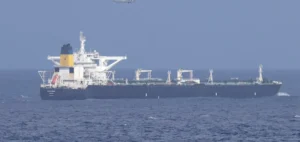Iran on Wednesday seized a Panama-flagged oil tanker that was transiting the Strait of Hormuz, the U.S. Navy announced, noting that it was the second such incident in Gulf waters in a week.
The United States called on Iran to “immediately” release the tanker seized in this highly strategic maritime zone, a quasi-exclusive shipping lane to connect the Gulf oil countries to world markets. The Niovi left Dubai on its way to Fujairah, another port in the United Arab Emirates, when it was chased by boats of the Revolutionary Guards, the Islamic Republic’s ideological army, said the U.S. 5th Fleet, based in Bahrain.
These Iranian ships “forced it to turn around and head for Iranian territorial waters,” she added. The U.S. Navy published a video of the tanker surrounded by a dozen boats. “The Tehran prosecutor announced that the ship Niovi was seized by the Guardians’ navy on the basis of a complaint and an order from the judicial authority,” reported the Iranian justice website, Mizan Online.
About 30 people were on board the ship, including the Greek captain and Filipino and Sri Lankan crew members, a Greek coast guard spokeswoman told AFP. The Iranian army had already seized a Marshall Islands-flagged oil tanker bound for the United States in the Gulf of Oman on 27 April. Tehran had claimed that the vessel had tried to flee after a “collision” with an Iranian ship that resulted in injuries. According to TankerTrackers.com, the tanker is still in the Iranian port of Bandar Abbas.
According to the British maritime security company Ambrey, these incidents come after the seizure in April by U.S. forces of a Greek tanker carrying Iranian oil. “The Greek authorities had warned at the time of the increased risks for Greek vessels,” said Ambrey, noting that the Niovi is also owned by a Greek company.
“Familiar pattern”
“We join the international community in calling on the Iranian government and the Iranian Navy to immediately release the ship and its crew,” U.S. State Department deputy spokesman Vedant Patel said Wednesday. Incidents have increased in this crucial maritime zone for global oil transportation since the United States withdrew from the international agreement to limit Iran’s nuclear program in 2018, reimposing sanctions on the Islamic Republic targeting its oil sector in particular.
“What we are seeing now is a return to the very familiar pattern of US sanctions pressure and Iranian counter-pressure that led to frequent attacks on maritime and energy infrastructure” during the time of former US President Donald Trump, Torbjorn Soltvedt of risk intelligence firm Verisk Maplecroft told AFP. “The message Iran is sending today is the same as it was then: Tehran is ready to counter U.S. efforts to curb Iranian oil exports,” he added.
Iran has intimidated or attacked 15 merchant ships over the past two years, the U.S. Navy said Wednesday, denouncing acts “contrary to international law.” It denounced “unjustified” and “irresponsible” measures that constitute a “threat to maritime security and the global economy”. The United States regularly criticizes Tehran’s actions in this maritime zone.
In 2019, the Revolutionary Guards had seized a British-flagged oil tanker, before releasing it two months later. In 2022, an Iranian navy flotilla briefly seized two unmanned U.S. military vessels in the Red Sea.






















